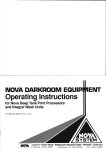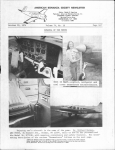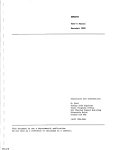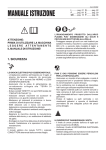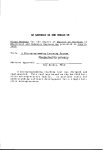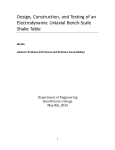Download Memmert UE 800 Operating instructions
Transcript
OPERATING INSTRUCTIONS Electronically controlled Ovens with programme controller Models 500 - 800 tbngratulations on your choice of a MEMMERT oven! Manufactured in West Germany using the latest production techniques and finest materials available, you now possess a technically superior and fully developed product. Your oven has already undergone extensive testing in our factory and by observing the following operation and service instructions you will be assured that the equipment will give satisfactory service over many years. The physical and chemical properties of your load (e. g. inflarrmation temp, e t c ) have strictly to be observed, as otherwise considerable damages (load, oven, surroundings of apparatus) can appear. Technical data summary Temperature range Quality of material Menmert is using stainless steel (Spec. 1.4301) for the external casing as well as for the interior, outstanding because of its high stability, optimum hygienic features and corrosion resistance against many (not all!) chemical combinations (attention e.g. at chlorine combinations!) By regular cleaning of the easy to clean interior, residues are avoided which at continuous influence can inopair the outfit and function of the oven. INSTALLATION OPTIONS Menmert ovens Series UEr BE, ULE with programme-controller are electrically heated. The temperature in the interior is continuously controlled by a microprocessor-controller with pulse package control. The power module is separated from the controller electronics by an optocoupler to ensure safe electrical isolation according to VDE regulations (not axplosion-proof, see "Loading1'). Ovens Series UE, BE have natural air circulation. Series ULE ovens have air circulation assisted by a fan. The doors are opened by pulling the door handles. Model 500 600 700 A mm 575 015 1055 in 22,64 32,09 41,54 B mm 920 1080 1240 in 36,22 42,52 48,82 From 5°C above ambient to nominal temperature = maximum temperature (see rating plate). The oven operates at ambient temperatures between 0°C and +27°C. Overheat Class 3.1 to DIN 12 880 fitted as standard (see table on safety device page 14). Electrical supply Single-phase or 3-phase a.c. supply 50 or 60 Hz. For voltage rating see rating plate. Protection Class 1. Operating insulation with ground conductor to VDE 0700, Protection IP 20, no humidity protection to DIN 40 050. Interference suppression Grade N to VDE 0875. For Switzerland The rrodels UE 600, ULE 600 are to be connected to 220/380 V 3N~ only. fig. b fig. c Attention! Installation options Optimum control and thermal conditions can only be ensured if the unit is hung or positioned accurately horizontally (use spirit level if necessary). If using a stand (accessory for models 500 to 700f fig. c) or if having model 800, then ensure that the floor is level. Ensure at least 150 inn (series UE/ULE) resp. 80 mm (series BE) clearance between back of oven and wall. The distance between ceiling and oven should not be less than 200 nrm. After the cabinet has been set horizontally the door can be adjusted if required (see Service Instructions). Extremely strong shocks during transport can cause a displacement of the temperature sensors in the holding clips inside the working space. Take care before the first putting into operation that the temperature sensors are checked on their correct position and if necessary slided cautiously into the holding clip resp. pulled out of the holding clip (see drawing). Model 800 is movable. The front castors are lockable by means of a fixation. In order to grant the stability the front castors must always be adjusted to the front for locking. Wall mounting Up to model 700 for all ovens metal mounting brackets (see (except fig. a) are available. Mounting bracket is delivered with model 800) incombustible plate. Dimensions of fixing screws and dowels depend on the weight of the charge and the quality of the wall. Stacking version (not with model 800) ceiling of working space Where the requirement is for two ovens of the same size to be placed one on top of the other, the oven with the least working temperature should be placed at the bottom (fig. b ) . Remove the front feet of the top oven and replace them with the ones supplied with the stacking device (only if the ovens are not originally supplied with the stacking device.) Remove the top of the bottom oven and turning it upside down place the drilling jig into the back corner. Mark out the hole position and drill a 4,2 mm diameter hole. With the screws provided fix the centering cylinders into position and re-fix top cover. Model 700 can only be stacked with an intermediate frame. Warning! Before retroving top cover - pull out plug! Attention! Take special care when working at high temperature. Outside case temperature may be high. back panel of ^ ^ working space S SffiKEDJGUP 8 2 6 17 7 14 18 16 12 Putting into operation 19 liLllTlH 1 • E:: \ 3 .5 \ 4 1a \ 1 13 15a 15 x ; 9a fig. d NORMAL OPERATICN Setting the To select the desired temperature with knob 1 it is netemperature . cessary to operate key 6. While the key is depressed the digital temperature indication 7 switches to setpoint selection resp. nominal value indication, indicated by a blinking point in the display. The setpoint indicated can only be changed with knob 1 when key 6 is pressed* If knob 1 is moved quickly, the setpoint is adjusting in large steps while it changes in single steps upon slow operation. After releasing of key 6 the setpoint adjusted is still shown for a short time (blinking point)• Thereafter it switches automatically on the actual value. Then scale can be locked with the screw la to prevent unintentional changes. When key 6 has not been operated the digital display 7 always indicates the actual temperature inside the chamber. Operating the key displays the selected temperature setting (blinking point). Set the adjustable overheat contoller TWW with knob 9 above the selected working temperature by an appropriate amount (e.g. 5°C). This scale can also be locked. The selected setpoint of the overheat controller TWW can always be read on the temperature display 12. Set the main switch, rotary knob 2, to position I. The green signal lamp 3 shows that the oven is ready for operation. After switching on the minimum temperature (20°C) is indicated. The yellow signal lamp 4 indicates the state of the heating. Steady conditions have been reached when the desired temperature can be read on the built-in digital temperature indicator. 7 for several tiires (during a period of at least 15 minutes). In order to provide optimum protection of thermic sensitive load against overtecnperature in case of failure of the thermostat, move the overtemperature controller TWW now down with the knob 9 until it just does not operate. This setpoint-reduction should be effected very slowly step by step for one digit (resp. one rest) exiguously above the actual steady temperature (approx. 3°C resp. at incubators approx. 0,5°C). Fault: If the selected operating temperature is exceeded due to a fault in the temperature control circuit, the temperature control is taken over by the overtemperature controller as soon as the temperature set with rotary knob 9 and shown on display 12 has been reached. This is indicated by alternate flashing of the red signal lamp 5. The unit must be checked immediately by a qualified electrician. In case of a short switching off (up to 10 sec.) the fixed setpoint can be seen on the display. dPERATTCN WTIH PROGRflMHEHXNITOllER Setting the temperature To select the desired temperatures with knobs 1 resp. 15 it is necessary to operate keys 6 resp, 14• While the keys are depressed the digital temperature indications 7 resp. 16 switch over to setpoint selection resp. nominal value indication, indicated by a blinking point in the corresponding display. The setpoints indicated can only be changed with rotary knobs 1 resp. 15 when keys 6 or 14 are pressed. If rotary knob 1 resp. 15 is moved quickly, the setpoint is adjusting in large steps while it changes in single steps upon slow operation. After releasing of key 6 resp. 14 the setpoint adjusted is still shown for a short time (blinking point). Thereatter it switches automatically over to the actual value. The scales can be locked with the screws la and 15a to prevent unintentional changes. As there is only one overheat controller, its temperature nominal value has to be set about 5°C above the respectively higher set nominal value of one of the both (programme-) temperature controllers. For example: Temperature controller 1 nominal value 70 °C Temperature controller 2 nominal value 110°C Overheat controller about 115°C The heating and cooling times until the appropriate setpoint is reached depend both on the load inside the oven and on the ambient temperature and must be taken into account when setting the timer riders. An example is shown in the illustration below: When keys 6 resp. 14 have not been operated the digital displays 7 resp. 16 always indicate the actual temperature inside the chamber. Operating the key displays the respectively temperature setting (blinking point). Operation time of both regulators is adjusted by programme timer 13. Time of operation for temperature regulator 15, is adjusted by pushing individual switch buttons (red section is visible). If switch buttons are not pushed (black section is visible) , temperature regulator 1 is in operation. The operation of each regulator is indicated by signal lamp 17 and 18. Time (actual time) can be adjusted by turning timer 13 (direction of arrow). Putting into operation Set the main switch, rotary knob 2, to position ( 3 • After switching on the previous setpoints are indicated (they are stored for approx. 1 month). The prograirme runs continually. Switching off by hand with main switch 2 to position 0. Function of safety regulator is the same as under operation11. l? Normal red area Actual time 10.00 hrs. Temperature controller 15 was in operation between 8.00 and 9.30 (riders pushed in). Temperature controller 1 is now operating. Change-over back to controller 15 at 11.15. Operation with timer final switching off (option) (fig. d/19) Select the temperature as described under "Operation with prograrmie-controller". Set knob 2 of the main switch to position ( 3 • Turn rotary knob 19 clockwise up to the stop, and then turn it back to the required time setting. The oven switches off when the set time has elapsed. Temperature recorder (accessory) Fresh air ventilation The load must not be packed too tigthly in order to ensure free air circulation. Do not place anything on the bottccn, against the sides or underneath the top of the working space (heating ribs). The ovens can be fitted with temperature recorder 11 as shown in fig. d. The sensor of the operational controller is used as the temperature sensor. Full instruction manuals are supplied with the recorder. The fresh air flap in the vent tube is operated by the slide control 8. In position 0 the flap is closed, giving free internal convection circulation on Series UE, BE and motorised fan recirculation on ovens Series ULE. By opening the flap the air in the working space can be renewed to a limited extent. Position 6: Maximum entry of fresh air (but not operation with fresh air only!). Intermediate positions permit selection of the appropriate mixing ratio. For maximum number of shelves and permitted loading see page 14. With unsatisfactory loading (packed too tightly) and the flap completely open it is possible that the oven may take a very long time to reach the selected temperature. Important 1 When the oven is started up for the first time it should be run under supervision until steady conditions are reached. Important: With a large proportion of fresh air the selected setpoint temperature may not always be reached. In that case the air flap should be closed slightly in order to compensate with a higher heating power for the energy loss caused by the fresh air intake. loading Ovens described in this instruction manual must not be used for drying or heating items giving off vapours which are inflamnable when mixed with air. 11 MAINTENANCE General information MEMMERT appliances require very little maintenance . It is recorrmended that the moving parts on the doors (hinges and door lock) should be lubricated with a thin silicone grease once a year (with continuous use 4 times a year). A well-fitting door is an essential requirement for ovens. Oi Memmert ovens the tight fit of the door is ensured trough seals both on the cabinet and on the door. The door seal presses exactly on the cabinet seal. With continuous use the flexible sealing material may becarie "set11. It may be necessary to adjust the door at the hinges and/or the locking plate area to ensure that the door closes properly. Adjusting the door After releasing the screw 16 the door can be adjusted by turning the eccentric 17 in the direction of the arrow (using a screwdriver). In addition the upper part 18 of the door hinge can be slightly moved in the direction of the arrow after releasing the 2 screws at the top and bottom of of the door. Check list for rectifying faults - this work must only be carried out by a qualified electrician Fault Cause Rotary knob 2 in position I, green lamp 3 not on Equipment not connected up Lamp faulty No temperature indication on the display Microfuse defective Yellow lamp 4 not on Ambient temperature too high Working temperature in oven higher than the working temperature set with rotary knob 1 (set point) Lamp faulty Display: "E-l" Circuit element TRIAC defective printed wiring board of mains supply unit 55046.x has to be changed Display: "E-2" Heating defective, the oven does not heat any more Display: "E-3" PT 100 defective The locking plate can also be adjusted in the direction of the arrow after releasing the screw 19. 13 The table below contains reconxnendations on shelves and loading to ensure unifonn temperature distribution within working space. Model Max. number of shelves Total load kg Load each shelf nax. kg 500 5 15 50 600 7 30 80 700 8 30 100 800 10 30 160 The details in these Operating Instructions must be fully observed in order to ensure correct operation of the oven. Class Lr Jl d O J 2 3.1 Aim of protection Protection of the oven, the environment and the contents of the oven Scope of protection No risk originating either from the oven or its contents in the event of a fault Safety device TWB In case of fault TWW with the load is pro- Monitoring function for tected against overheating excess teaperature Safety Measures If the instructions are disregarded any claims under warranty are invalidated. Special safety Measures required depending on the purpose for which the oven is used (c) by MEMMERT GrrtbH+Co.KG 01.90









